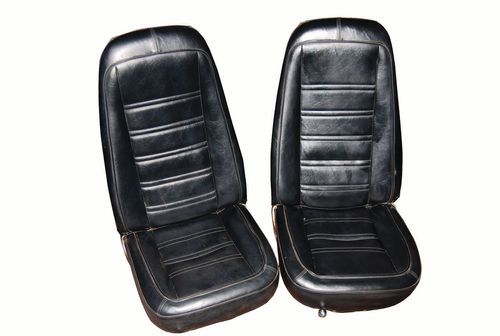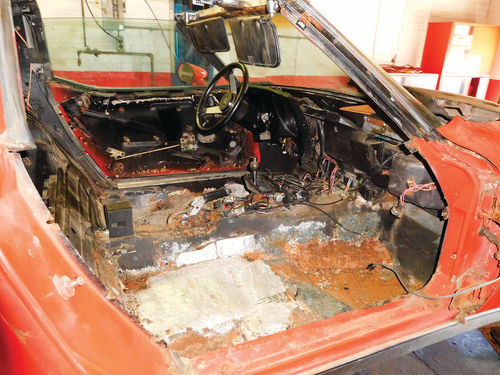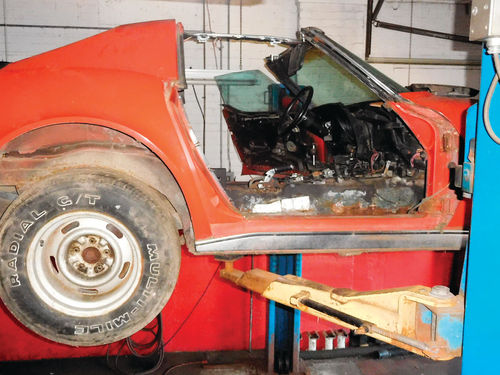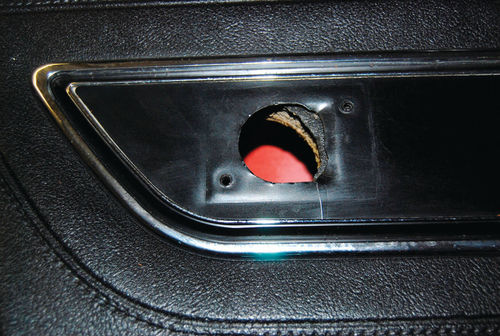Heidi's Orange Corvette
As You Might Expect, There’s More to This Project Than Was Originally Anticipated. So Along With Working on the Car, the Young Restorer Is Working to Stay Inspired.
Heidi Schaffer is finding out that restoring a car is not an easy job. In the September issue you read about how this young mechanic had plans to turn a neglected ’77 Vette into a nice driver on a tight budget. Since that time she has been working on a number of tasks including gutting the inside of the car and disassembling the vacuumoperated Hide-Away headlights.
“I may also have to redo some of the floor, because it’s getting kind of thin,” Heidi told us.
Although the Corvette has a fiberglass body, the floor pans have metal in them and the “tin worm” has attacked Heidi’s passenger-side floor. The bad sheet metal may have to be replaced.
Heidi pointed out that damage to that floorboard, unfortunately, is extensive. “You can see all the rust on the passenger side floorboard,” she noted. “I think it’s kind of decaying. The underside is a little rusty, too, but it’s not as bad as the floorboard. It’s just the passenger side and I can see it through a hole in the floor. It’s kind of moving a little bit. I might have to cut it out and weld in a new piece.”

Something Special for the Wheels
Heidi also took the Corvette wheels off one side of the car so they could be re-plated. She replaced them with some other wheels she had, but those wheels scrape against the brake calipers and don’t turn. When she tried to push the car closer to her workbench, it wouldn’t move that far. During any restoration job, the need to move a car around the shop is something that has to be considered and planned for. Heidi is learning such things as her project unfolds.
Eventually Heidi is going to have all of the wheels nickel-plated. Why? Because a friend of her father’s does that kind of work. “It’s going to be different,” Heidi admitted. “My dad had the split rims on his Pierce-Arrow done in nickel and it kind of looks cool. It looks better than chrome and I think it’s nicer than paint.”
Heidi said her father’s friend likes doing nickel plating and will give her a “friend’s discount” so the price will be very reasonable. She’ll have to not be in a hurry though, since he does them only when things are slow in his shop.
Her Plans Call for Swapping the Engine Twice
The engine in the car is the original 350-cid V-8 that came with it from the factory. For budgetary reasons, Heidi plans to replace that factory engine with another 350-cid V-8 instead of rebuilding the original one right now.
“What I really hope to do, so this isn’t an eternal project, is get a readyto-go 350 engine to drop in so I can drive the car sooner, rather than later,” she said. “Then I want to rebuild the original engine just to get the engine rebuilding experience. But I want to do that on the side and make it how I want it. Then I can drive the car sooner with whatever engine I can find that’s already running.”

Heidi already has a Turbo HydraMatic 350 transmission that she’s rebuilding. “I’m going to overhaul it and then see if it will work with whatever engine I get,” she said. “That’s because it’s more electronically controlled than the one in the car.”

Heidi also is working on rebuilding the carburetor and has been taking everything off the body of the Corvette so that she can prep the car for painting. “I’ve also been working on getting the headlights out, which is kind of a job because they’re so complex,” she said.
The Corvette’s hidden headlights have a lot of brackets and the motors need to be overhauled. According to Heidi, there are so many vacuum lines behind them that it gets hard to sort them out.

“Since they’re vacuum-operated, they’re designed to go up if you lose vacuum so you have lights,” Heidi explained. “There’s tons of lines back there and lots of brackets. It’s very complicated. That surprised me. It’s very messy. I’ve been taking out many clips and labeling them. I started taking apart the front bumper and separating the pieces. It’s not as easy as I thought it would be.”

Getting a Helping Hand
A local hobbyist named Tim Buttles has offered to give Heidi advice on doing bodywork, but she is going to do the hands-on herself.
Heidi said that Tim has helped her “a little bit” so far. “He has the materials,” she explained. “I need to work on getting all of the internals out of one door that’s partially taken apart and Tim’s going to teach me how to do fiberglass work and patch things up.”

About That Hole In the Door…
With one door completely removed from the car and the other partly dismantled on the inside, Heidi has plans to fix the scratch on the detached passenger’s side door and fix up the driver’s door as affordably as possible. “The left-hand door has a few broken pieces, but I went online and found a door kit that will just replace some of the pieces that are broken. I’ll just replace the broken pieces so the power windows and door locks work.”

Heidi also went online to try to buy new interior door panels and found out that they cost $1000, which is way beyond “affordable” with her low budget. So she plans to restore the old ones.
“They’re in pretty good shape,” she pointed out. “I cleaned the carpeted areas on the doors and painted the panels. I’m going to try to figure out a way to fix a hole that was cut out of one door panel.”
This Vette Isn’t a “Simple” Car
We asked Heidi if restoring the Corvette was more work than she anticipated at first. “Yes,” she said. “Being an old car, I thought it was simpler than the modern cars I fix at work, but I guess Corvettes were more engineered than other cars of their era. They were trying new things on these cars and it kind of surprised me.
“But I keep trying to inspire myself by looking at finished cars at car shows to see what other people have done to their ’77 Vettes.”
Heidi said she goes to shows and takes pictures of other cars like hers. She has seen some cars that were correctly restored and others with engine swaps like she plans to do. She also notices things on the show cars. For instance, she determined that some work had been done on her car’s wiring over the years. “The way the wires are laid out doesn’t look just right,” Heidi said.
Stay Inspired Through the Setbacks
Knowing what she knows now, is she still glad that she started her Corvette project? “Some days I am and some days are kind of frustrating,” she said. “It’s especially hard when you work on cars all day and then you come here and struggle with this or that, but when I get feeling frustrated, I work on something I like such as taking off all the emblems and repainting them. I like the fine detail work a lot. It’s more enjoyable to me. Also, if I have an easy day, I’ll get more ambitious the next time and try to take apart more of the headlight mechanism.”
Heidi also gets a little philosophical about restoration work. “I guess that people who are trying to stay inspired to restore their car should just find ways to keep inspiring themselves,” she’s decided. “Like the way I go to car shows to look at finished cars like the one I’m building. That always gets me more inspired. It shows me that people have done it previously and shows what they have done.”















